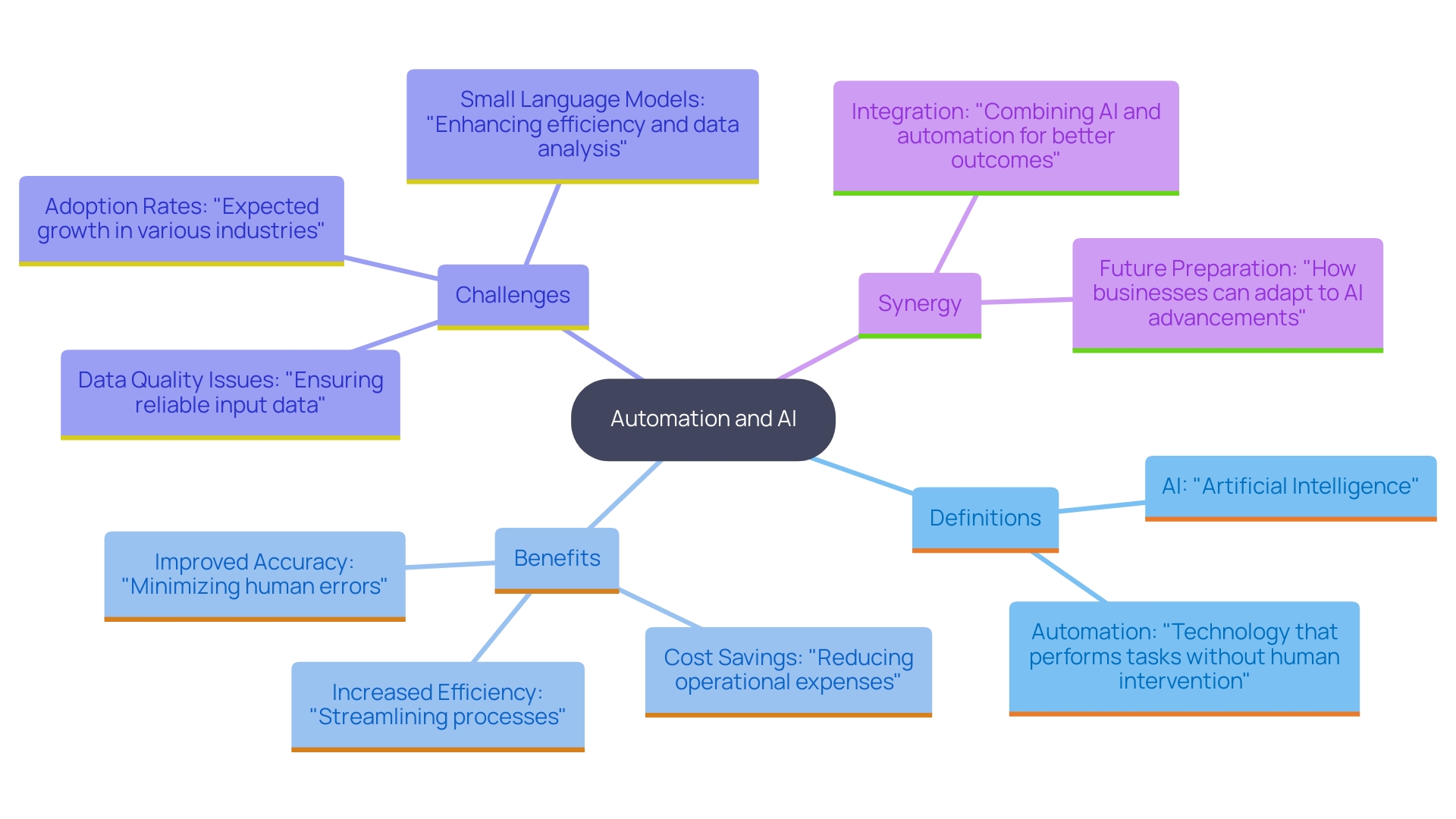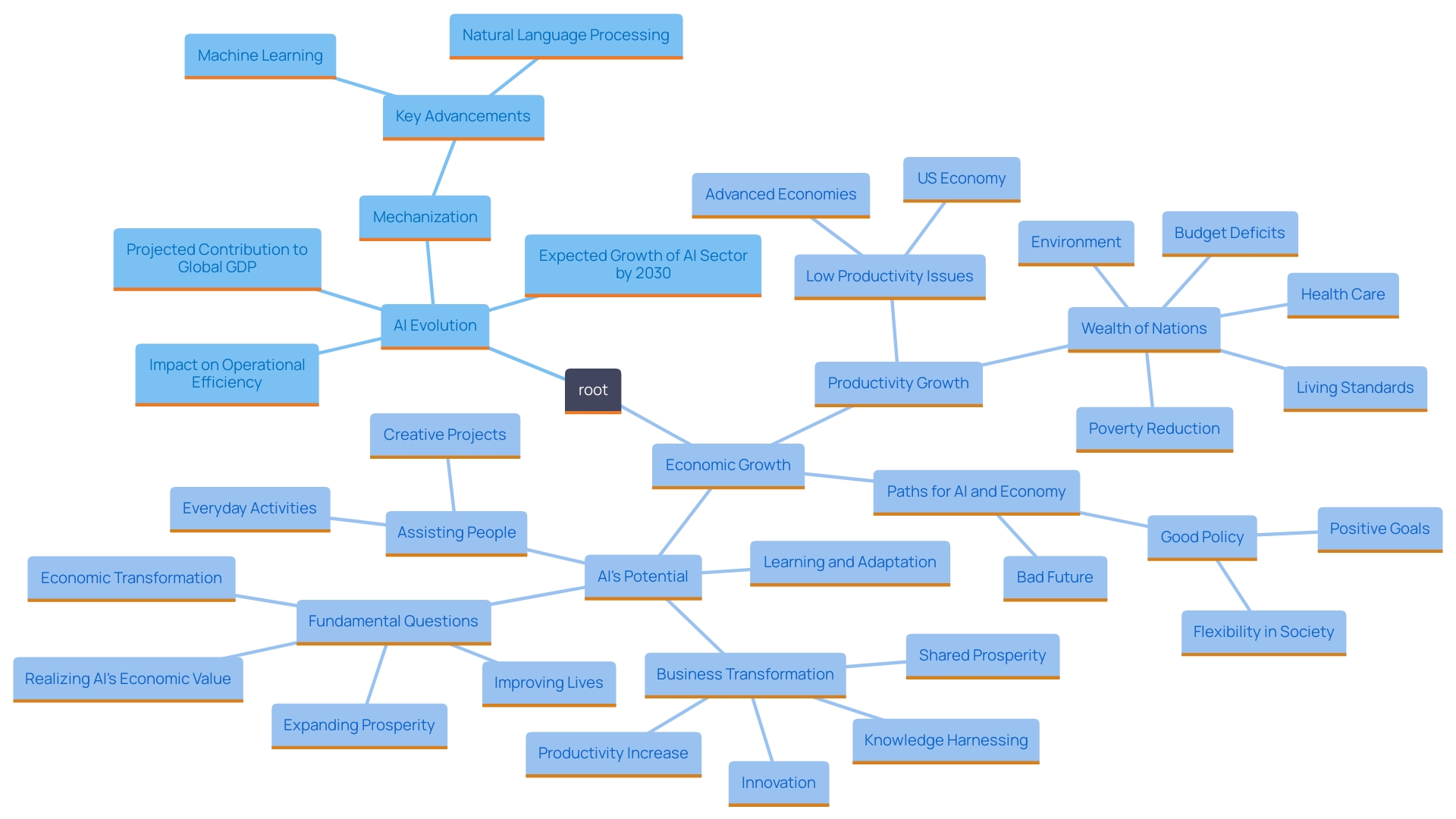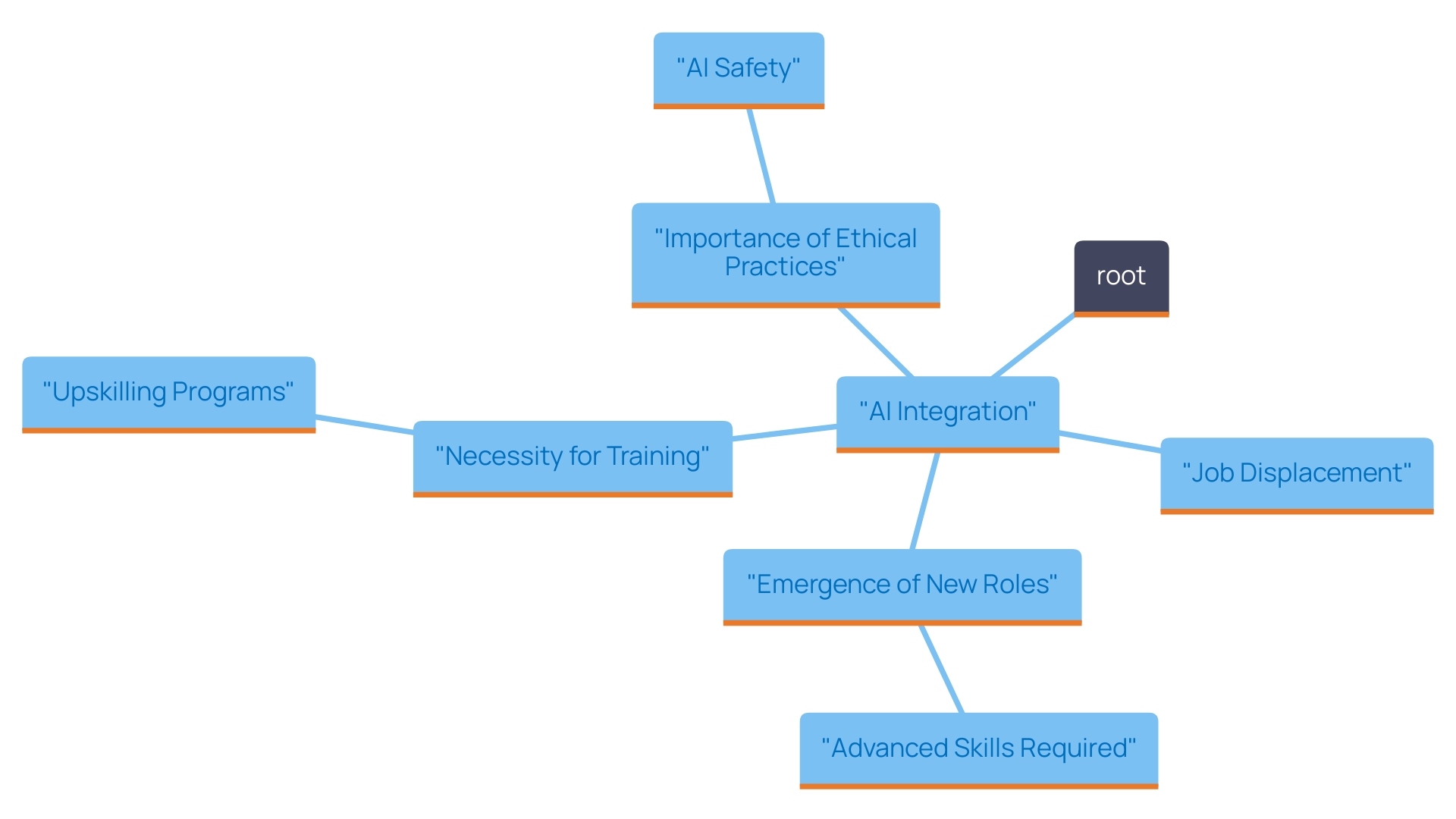Introduction
In a world where operational efficiency is paramount, the integration of automation and artificial intelligence is reshaping the business landscape. As companies strive to enhance productivity and streamline processes, understanding the nuances of these technologies becomes essential. From reducing manual tasks to harnessing the power of data, automation and AI present a unique opportunity for organizations to not only improve their operations but also to foster innovation.
However, the journey towards embracing these advancements is not without its challenges, including concerns over data quality and the complexities of implementation. By exploring the evolution, applications, and impacts of these technologies, businesses can uncover practical strategies to navigate this transformative era and unlock their full potential.
Defining Automation and Artificial Intelligence
Automation is described as the system that carries out activities with minimal human involvement, intended to improve efficiency and decrease the need for manual intervention. It encompasses a wide range of tools and systems, from simple mechanical devices to advanced software solutions that streamline processes. In contrast, Artificial Intelligence (AI) represents a specialized branch of computer science focused on developing systems capable of executing tasks that typically require human intelligence, such as problem-solving, natural language comprehension, and pattern recognition.
Recent statistics indicate that by 2024, approximately 75% of organizations are expected to embrace automated technologies, underscoring a significant shift towards operational efficiency. However, many organizations encounter challenges related to poor master data quality and may hesitate to adopt AI due to perceived complexities and high costs. These concerns are common, as many view AI projects as time-intensive and difficult to implement. Addressing these perceptions is essential for unlocking the full potential of AI.
Integrating Small Language Models (SLMs) can help businesses achieve efficient data analysis, enhanced privacy through on-premises deployment, and cost-effectiveness due to lower computational power requirements. Together, automation and AI create a powerful synergy that significantly enhances operational processes. By enabling machines to perform tasks and make informed decisions based on data analysis, organizations can improve efficiency and foster innovation in their operations.
As Claude Shannon, a renowned mathematician and computer scientist, aptly stated, ‘I visualize a time when we will be to robots what dogs are to humans, and I am rooting for the machines.’ This perspective invites us to reimagine the evolving dynamics between humans and AI, encouraging a collaborative future where technology empowers us to achieve greater operational excellence. Ultimately, technology and AI can convert raw data into actionable insights, driving informed decisions that propel businesses forward.

The Evolution of Automation and AI
The process of mechanization began during the Industrial Revolution, marked by the introduction of machines designed to perform repetitive tasks, significantly enhancing productivity. As technology progressed, automated processes evolved into more sophisticated systems that incorporated electronics and software, allowing for the execution of complex functions. The roots of artificial intelligence (AI) can be traced back to the mid-20th century, with early research primarily aimed at mimicking human cognitive functions.
Key advancements in machine learning, neural networks, and natural language processing have transformed AI into an essential element of modern operational strategies. These innovations enable businesses to harness and analyze data in unprecedented ways, driving efficiency and effectiveness across operations.
A compelling case study demonstrates how a mid-sized company significantly improved operational efficiency by implementing GUI tools to streamline data entry, enhance software testing, and integrate legacy systems. This initiative not only reduced data entry errors by 70% and accelerated testing processes by 50%, but also improved overall workflow efficiency by 80%. Notably, the ROI from this automation initiative was achieved within just six months, showcasing the transformative power of automation in healthcare service delivery.
Looking towards the future, the potential impact of AI is staggering. It is projected that AI will contribute to a 14% boost in global GDP by 2030, underscoring its importance in promoting productivity and innovation. According to research expert Bergur Thormundsson, the AI sector was valued at approximately 200 billion U.S. dollars in 2023, with expectations to exceed 1.8 trillion U.S. dollars by 2030. Furthermore, a case study exploring the expected impact of AI on various sectors—including healthcare, education, and transportation—highlights its vast potential, signifying a transformative era for enterprises eager to embrace these technologies.

Applications of Automation and AI in Business
Automation and AI are revolutionizing business processes across various sectors, driving efficiency and significantly enhancing productivity. In manufacturing, robotic process technology has become essential for performing repetitive activities such as assembly and quality control. For instance, a leading automotive manufacturer implemented our EMMA RPA tool, which not only addressed these repetitive tasks but also reduced employee fatigue, thereby improving morale. This innovation allows human employees to concentrate on more intricate and strategic tasks, aiding a smooth shift from obsolete systems to intelligent processes. Significantly, the automotive sector has witnessed a concentration of these innovations, streamlining operations and boosting overall output.
Transitioning to customer service, AI-powered chatbots have emerged as vital tools for providing instant support. A prominent retail company reported a 30% reduction in operational costs after deploying AI chatbots, which enhance the customer experience while contributing to efficiency. As companies increasingly utilize automation for enhanced service delivery, the significance of such innovations continues to expand.
In the healthcare sector, AI is making significant strides by utilizing predictive analytics to enhance patient outcomes through effective resource management. For example, a healthcare provider used AI to predict patient admission rates, allowing for timely interventions and optimizing care delivery, showcasing the technology’s versatility across various functions.
Furthermore, AI-driven analytics tools empower organizations to extract actionable insights from vast datasets. By harnessing these insights, organizations can make informed decisions and engage in strategic planning, positioning themselves effectively within competitive markets. A recent study found that companies using AI analytics reported a 20% increase in decision-making speed, underscoring its value.
As we enter 2024, statistics show a sustained upward trend in the adoption of automated systems and AI applications across various business sectors. This trend is defined by the increasing integration of robotic process technology in manufacturing and an expansion of AI applications in customer service, healthcare, and beyond. Recent data indicate that organizations enhancing their human capital alongside these innovations will experience the most significant improvements in productivity. Daron Acemoglu observes, ‘But at the same time, by the same token, this raises the need for mechanization.’ This highlights the significance of aligning tools with human expertise to maximize operational efficiency and drive sustained growth.

The Impact of Automation and AI on Workforce Dynamics
The integration of automation and AI into organizational processes offers profound implications for the workforce. While these innovations can result in job displacement in routine areas, they simultaneously generate opportunities for new roles that require advanced skills in managing and maintaining AI systems. Our GenAI workshops empower businesses by providing personalized customer experiences through AI-powered chatbots and recommendation systems, enhancing employee engagement and customer satisfaction. A recent study indicates that 72% of companies employing AI view it as a tool that streamlines activities and enhances responsibilities, suggesting these technologies complement human roles rather than replace them.
As employees transition to more strategic and creative tasks, organizations can experience a surge in innovation. To thrive in this evolving landscape, organizations must invest in comprehensive training and upskilling programs, such as our hands-on training workshops that equip teams with practical skills to implement AI solutions effectively, including the latest advancements like ChatGPT 4.0. ChatGPT 4.0 specifically enhances interactions by providing more nuanced and context-aware responses, making it a valuable asset in customer engagement and support.
Additionally, with the demand for childcare workers projected to increase by at least 100%, it is clear that while some jobs may be displaced, new opportunities will emerge in various sectors. This underscores the importance of continuous learning and adaptation in the face of technological change, as businesses must prepare their workforce for these shifts to ensure sustainable growth. By embracing ethical AI usage and responsible practices, organizations can navigate the complexities of technological advancements while fostering a resilient and dynamic workforce.

Conclusion
Embracing automation and artificial intelligence is crucial for organizations aiming to succeed in today’s competitive landscape. These technologies enhance operational efficiency and drive innovation, fundamentally transforming business processes. The evolution from early automation to advanced AI applications underscores their importance in boosting productivity.
The diverse applications of automation and AI across various sectors reveal their transformative potential. Numerous case studies demonstrate significant improvements in efficiency and cost savings, highlighting the benefits of integrating human expertise with advanced systems.
However, the integration of these technologies also presents challenges, particularly in workforce dynamics. While some roles may be displaced, new opportunities requiring advanced skills will arise. To navigate these changes, organizations must invest in training and upskilling, equipping employees to thrive in an evolving environment.
Fostering a culture of continuous learning and ethical technology use will be essential for successful adaptation.
In summary, the journey toward automation and AI is a pathway to operational excellence and innovation. By addressing challenges and harnessing these technologies’ full potential, businesses can drive sustained growth and success. Now is the time to seize the opportunities that automation and AI offer and take decisive action toward a more efficient future.

